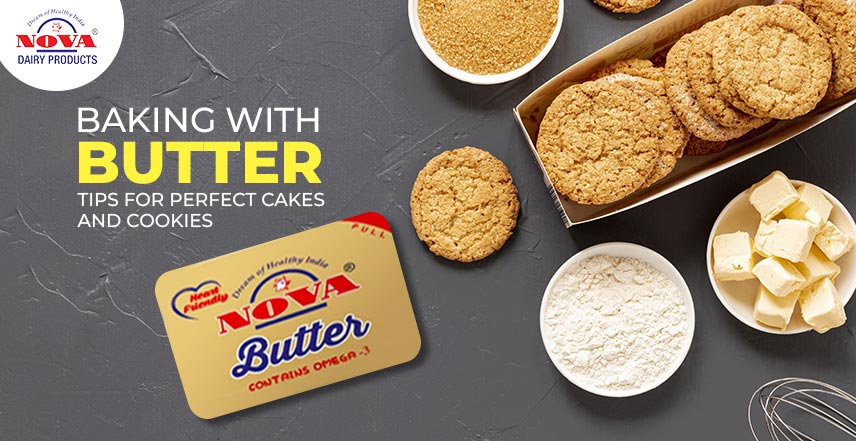You must have noticed that butter is one of the most used ingredients in many baked goods like cakes and cookies. It adds rich flavor and tenderness to any food item. Whether you’re a seasoned baker or a newbie, butter is an essential component in creating delicious baked goods. Its creamy texture and unique taste elevate the overall quality of your treats.
Ready to take your baked goods to the next level? Discover the secret to achieving a rich, buttery flavor and perfect texture. Explore our essential tips for working with Nova Butter and unlock your baking potential. With Nova Butter, you can achieve a light and fluffy texture in your baked goods while also enhancing the overall taste.
The Role of Butter in Baking
Butter’s importance in baking goes beyond taste. Here’s a breakdown of what butter contributes to your baked goods:
- Flavor: Butter has a creamy, rich taste that cannot be replicated with margarine or shortening. Its fat content makes cookies and cakes taste fuller and more indulgent.
- Texture: The fat in butter coats the proteins in flour, preventing gluten development. This is why butter creates a tender crumb in cakes and a melt-in-the-mouth texture in cookies.
- Structure: Butter adds structure to baked goods. When beaten with sugar, butter traps air, which expands during baking and helps to create a light, fluffy texture.
Baking with Butter: Tips for Perfect Cakes and Cookies
Butter, a main ingredient in countless recipes. From delicate cakes to chewy cookies, the right butter technique is essential. In this guide, we’ll explore essential tips to ensure your baked goods are moist, flavorful, and perfectly textured.
1. Keep the right Temperature
The temperature of your butter affects the final texture of your baked goods, so it’s essential to get it right:
- Softened Butter for Cakes: Room-temperature butter is the key to smooth cake batters. If it’s too cold, it won’t cream properly with sugar, resulting in a dense cake. To soften butter, leave it out for 30–60 minutes or cut it into smaller pieces for faster softening.
- Cold Butter for Flaky Cookies: For cookies, cold butter is often best. Cold butter doesn’t fully incorporate, leaving small pockets that create layers and add a slight chewiness to the cookies. This works especially well in recipes like chocolate chip or shortbread cookies.
-
Master the Creaming Technique
Creaming butter and sugar is one of the most important steps in baking because it builds the base structure of your dough or batter. The goal is to trap air to give your cakes and cookies a lighter texture.
- Don’t rush: Creaming can take 2–5 minutes, depending on your mixer’s power. Look for a pale and fluffy mixture.
- Check Texture: If the butter and sugar are properly creamed, the mixture should feel slightly gritty but not sandy.
-
Don’t Rush the Mixing
When making cookies, over-mixing your dough can make the cookies tough. This is because too much mixing develops the gluten in the flour, which can turn cookies from tender to tough.
- Mix Until Just Combined: Mix on low speed and stop as soon as the dough comes together. This ensures that you won’t overwork the dough.
- Hand-Mix the Last Few Stirs: For cookies with chunks, like chocolate chips, fold them in by hand. This gives you better control and avoids over-mixing.
-
Use a Cookie Scoop for Consistency
When making cookies, using a cookie scoop not only makes the process easier but also ensures that your cookies are evenly sized, which means they’ll bake uniformly. Butter melts at a low temperature, so if one cookie is larger than the other, you’ll end up with some under-baked or over-baked cookies.
- Uniform Size: A cookie scoop is ideal for drop cookies like chocolate chip or oatmeal.
- Chill the Dough: Chilling the dough before baking can prevent cookies from spreading too much and helps the flavors meld together.
-
Pay Attention to Oven Temperature
Butter in baked goods can be sensitive to oven temperature, so it’s important to get it right.
- Preheat the Oven Fully: An oven that’s too cold can lead to flat cookies, as the butter melts too quickly before the dough sets.
- Check for Hot Spots: Some ovens have hot spots, which can cause uneven baking. Rotate your pan halfway through baking to ensure even cooking.
Common Mistakes to Avoid
Even experienced bakers can make mistakes. Here are some common issues and how to address them:
- Overmixed dough: If your dough is tough, it may be overmixed. Rest it for a while to relax the gluten.
- Unevenly baked cakes: If your cake is unevenly browned, rotate it halfway through the baking time.
- Dry cakes: If your cake is too dry, it may be a result of overbaking. Check it for doneness earlier next time.
By following these tips and understanding the role of butter in baking, you can create delicious and flawless pastries and cakes. Remember to experiment, have fun, and enjoy the process of baking with this versatile ingredient.

